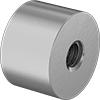Filter by
Finish
Fastener Strength Grade/Class
Flange Diameter
Locking Type
Thread Pitch
Flange Thickness
Performance
Thread Type
Thread Spacing
Thread Direction
Drive Style
Specifications Met
Washer Material
DFARS Specialty Metals
Export Control Classification Number (ECCN)
Other Products



















































